#minoan crete
Text



My most recent make is this ancient Minoan ensemble! It consists of a tunic (heanos) worn under a flounced wraparound skirt shaped like a double-bladed axe (labrys). Despite how heavy the linen skirt is, the entire outfit is surprisingly easy to move around in. I even waded into the river to rescue a bee!
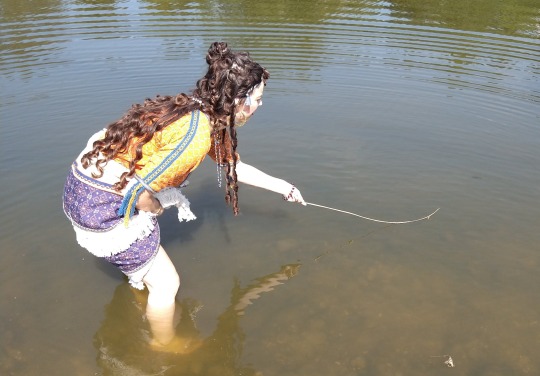
Hot Girl Activities
#minoan crete#minoan#ancient greece#greek mythology#historical costuming#bronze age#my costumes#clothing reconstruction#hot girl summer
5K notes
·
View notes
Text
I have the confidence of those men that think they could land an airplane but instead I just feel like I could be the first person to decode Linear-A if I really put my mind to it
278 notes
·
View notes
Text
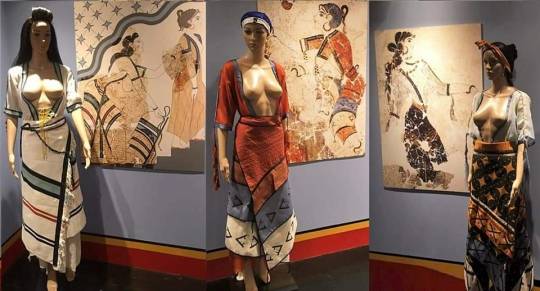

Reconstructions of Minoan women's clothing by Dr. Bernice Jones.
They can be seen at the Hellenistic Museum in Melbourne, Australia.
Photos by Tahney Fosdike
407 notes
·
View notes
Text

An Ariadne and Dionysus sketch I‘m not particularly pleased with
#my art#dionysos#dionysus#ariadne#greek mythology#hellenic polytheism#classical studies#mycenaean#minoan crete#bacchus#the sketches i dislike are always the ones to blow up#i swear if this recieves the same treatment-
390 notes
·
View notes
Text
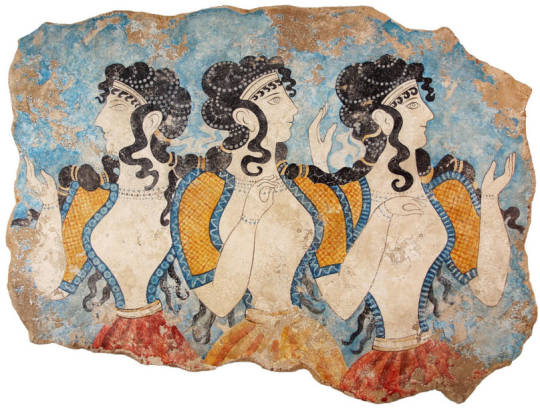
From ancient city of Knossos, Minoan Civilization on Crete, circa 2000 B.C.E.
312 notes
·
View notes
Text

my valentine @iliosflower
#digital art#digital illustration#artists on tumblr#digital aritst#art#artistsontumblr#digital drawing#my art#hellenic polytheism#greek mythology#hellenic pagan#hellenic worship#hellenism#minoan crete#minoan#crete#isle of crete#ancient minoan#ancient greek
380 notes
·
View notes
Text
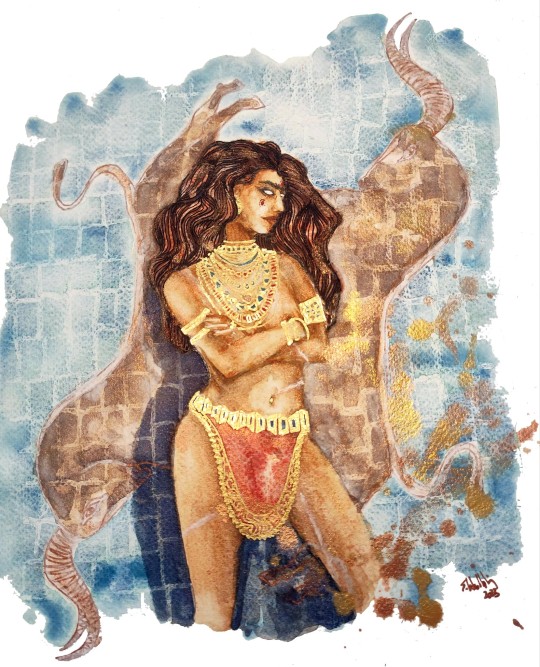
The Pride of Crete - Bull Leaper
Excavations in at the Palace of Knosses in Crete suggest the existence of ritual bull leaping. Acrobats, both male and female, vault over bulls displaying their skills and honoring the gods. Depictions of the sport can be found on frescoes, vases and statues.
Also I read Mary Renault's The King must Die and The Bull from the Sea and I am obsessed.
#minoan#minoan crete#minoan civilization#bull leaper#mary renault#the king must die#the bull from the sea#minos#minoan crete art#mycenaean#myceneaen greece#ancient greece#greek myth#greek mythology#greek mythology art#ancient greece art#traditional art#theseus
124 notes
·
View notes
Text

i just realized i havent posted any Minoan girl art on tumblr so here you go 🏺 (might need to turn your brightness up to see this one)
#artwork#didgitalillustration#my art#minoan#ancient greece#bronze age#ancient crete#minoan civilization#minoan crete#historical art#historical oc
14 notes
·
View notes
Text
taxi from spili to minoan monastiraki: 31.50€
entrance ticket: 3€
getting to take pictures of the site that even minoancrete.com doesn't have, meeting the rethymno ephorate of antiquities while she and her people are going around the site discussing how to make it better accessible for people: priceless
i'm probably going to be remembered by that taxi driver as an insane person because with the way the buses are set up there was no way for me to get there without having to stay overnight and there was nowhere coming up to stay, so i'm in agia galini, got the bus to spili, and then got the only taxi in that village to drive me to monastiraki, which confused everyone at first because the monastiraki that most people know about is in athens. it's a major tourist attraction! but crete monastiraki is just beyond amari, and it took a moment for this to get figured out.
then i followed the signs. and got lost. then i flagged down a car to ask for directions and the driver was going to the site, because he was helping the ephorate of antiquities and her assistant (??) with deciding how to lay down pathways and make the site more accessible because, let me tell you, there are about three actual pathways laid out and everything else is tramping through long grass.
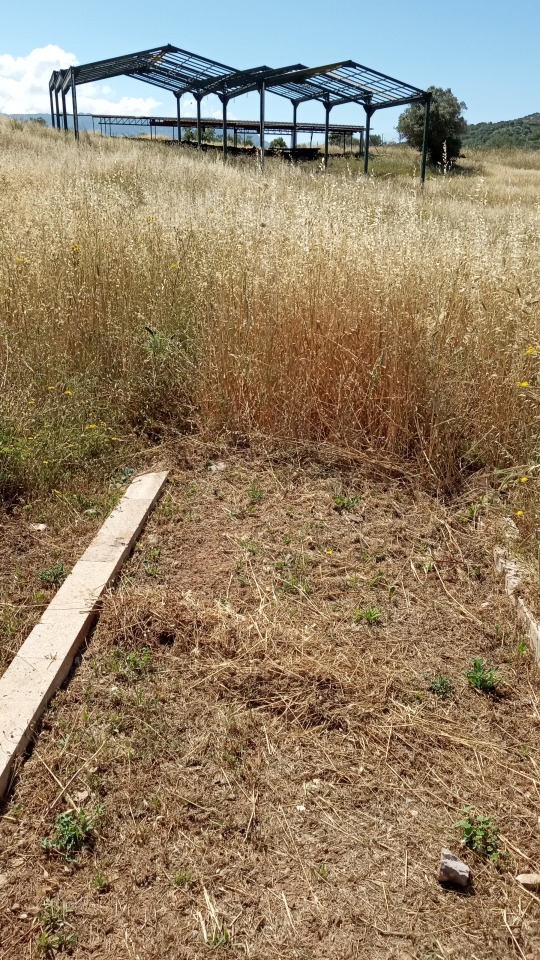
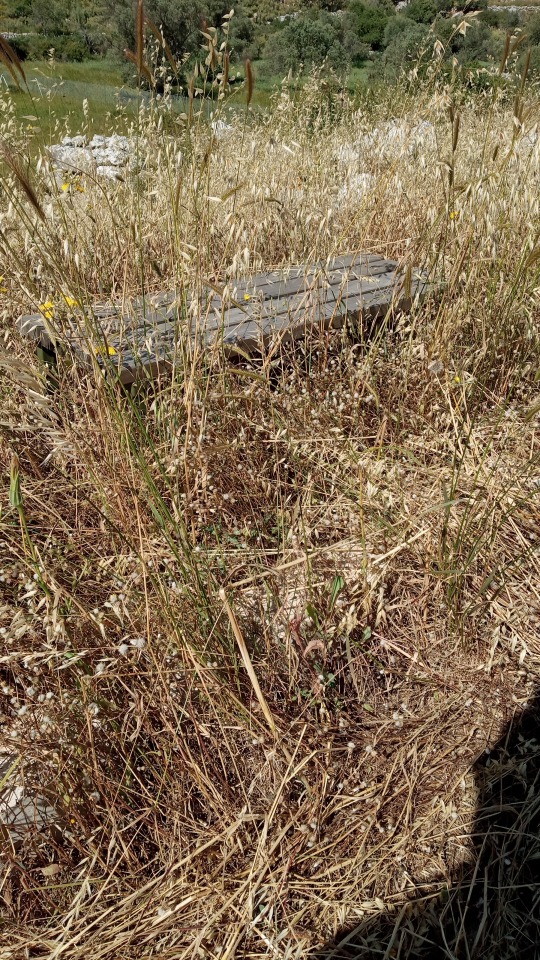
one of the paths just. stops. and these? the left part is the central court, covered in grass and flowers and everything.


the modern history of the site itself is very interesting considering that john pendlebury (one of my personal heroes, move aside indiana jones) was the first one to start excavating. the nazis took over looking at the site during their occupation of crete, working off of pendlebury's notes since they executed him when he refused to answer any of their questions (he was the leader of the british part of the cretan resistance. the nazis called him 'lawrence of crete' after lawrence of arabia).
this site was also excavated by athanasia kanta (also one of my heroes! she who is in charge of the knossos-anetaki dig, my beloved), and there's a nice portion of it beneath some coverings that i needed to rest under after being very careful not to turn any of my ankles.

i have a problem and it is my addiction to the 'panorama' function on my camera. also how my tumblr is now in portuguese.
29 notes
·
View notes
Text
Minoan Kilt
The large, structural skirt worn by Minoan women in art is instantly recognizable, and when I made my own I combined current best guesses with my own personal tastes.

My kilt shape follows the hypothesis laid out by Bernice Jones in her book Ariadne's Threads: The Construction and Significance of Clothes in the Aegean Bronze Age. She describes the shape of that of a labrys, a double-headed axe with apparent ceremonial significance in Ancient Minoan culture. This garment may be depicted in Linear-B logogram *166 + we, we-being the backwards-s-shaped squiggle in the center which identifies the piece as a garment.

See pages 336 and 341 in Marie-Louise B. Nosch, The Textile Logograms in the Linear B Tablets
Actual details on construction and materials below the cut:
Construction:
The top and bottom edges of the kilt are concave, so the sides are longer than the middle. This gives the chevron-shape seen on layered kilts in art. In addition, the curved top half makes the skirt flare out, accommodating the hips and giving more freedom of movement to the legs. My kilt measured from my waist to my anklebone at the longest point, and about 1.5 times around my waist.
I chose to make a flounced kilt, with smaller strips of fabric and trim applied to a large base piece, rather than a tiered kilt, in which multiple kilt shapes of varying length are layered one on top of the other, so you end up wrangling 3 layers of fabric around the waist. The flounced kilt saves fabric and gives you a lot more freedom with whatever trim you might want. Jones' diagram for a flounced kilt is seen below:

Unlike the version in the diagram above, I chose not to attach ties to the garment itself both because the linen I used was very heavy and I was concerned about weight, and also because folding the skirt and securing it with a separate tie worked just fine for my tastes. In total I had four flounces: 2 alternating rows each of fabric and fringe.
The vertical edges of most kilts are left plain, probably representing either the selvage or an edge otherwise finished off to prevent fraying. For my kilt, however, I ended up with a couple inches of self-fringe on either side as I adjusted the fabric to the correct width. At least three examples of kilts with fringed vertical edges are known, all three from the so-called "House of the Ladies" in Akrotiri
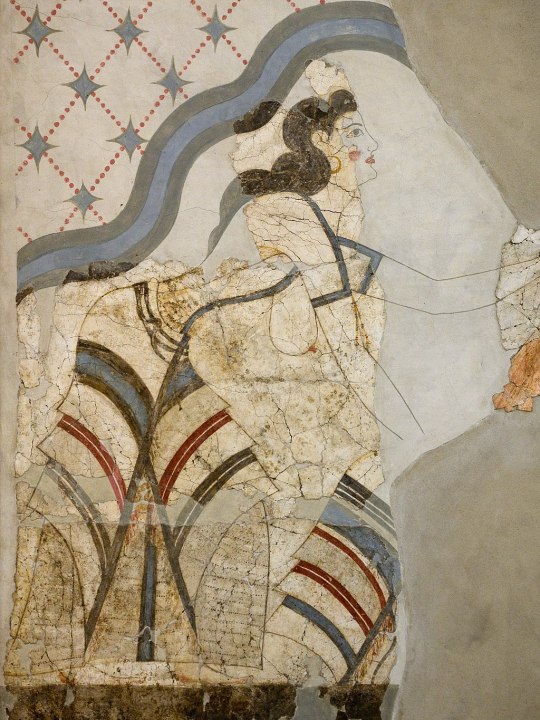

Photos from Wikimedia Commons. Image 1. Image 2.
The vertical edges of these kilts are reinforced with a colored band or tape, probably to keep the garment from unintentional further fraying. Accordingly, I did the same on my kilt. I also like that it gave a nice vertical diagonal to counterbalance the horizontal ones.
Materials
I tried to use mainly linen and wool, the fibers most available on Ancient Crete, but some of my trim was cotton because sometimes you just have to use what's cheap and available in the today times.
The base of my kilt is a heavy, patterned linen in what's called a diaper weave, meaning that a repeating diamond pattern is woven into the pattern itself. A lot of the Minoan textiles depicted in frescoes are characterized by repeating geometric patterns, likely woven into the fabric itself, and that was something I wanted to capture in my own piece. My linen is woven with both cream and natural colored threads. The heavy weight is important to give structure to the garment--otherwise it would be kind of limp. My linen was from Burnley & Trowbridge (shameless plug), as was the plain cotton twill tape I used to bind the top and bottom edges of the kilt, and the dark red wool twill tape I used along the vertical edges.
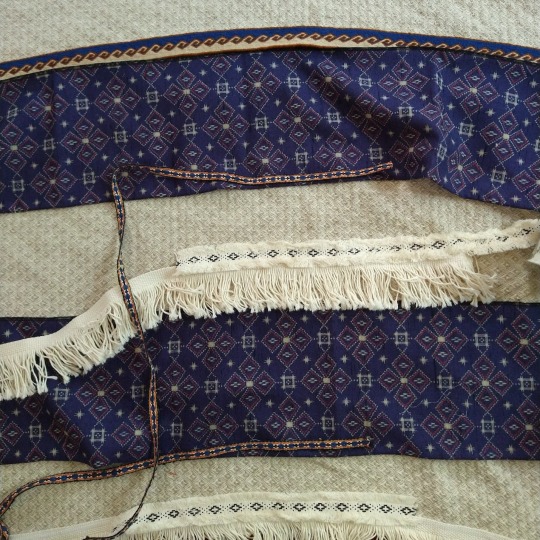
I bought my cotton fringe from a rug supply store. I had to search a while to find a fringe that would work for me, and I ultimately chose fringes with a woven header rather than the more common knotted one, so that it would lay flat against the kilt. I hid the woven header under a layer of cotton fringed trim from Michaels (yes, Michaels) with this really great diamond and dots pattern woven in black.
The blue layers are from a bolt of vintage wool Kimono fabric. Blue appears frequently in frescoes, likely achieved with indigo or woad dye, or even murex/mollusk dye. The fabric is printed with an imitation ikat pattern of diamonds and squares that made me think "the vibes seem right!" because quite frankly, you aren't going to get "historically accurate" Minoan textiles (which there probably isn't enough archaeological evidence to definitively describe) without, like, hand-weaving it yourself or paying someone hundreds of dollars to do it for you (and that price is if the weaver really likes you). Neither of which appealed to my desire to just make a fun, low stress project. Good enough is good enough.
The narrow trim on the bottom of the blue flounces is vintage cotton/poly woven trim. This trim, while narrow, was quite thick and stiff, which was great because it added more weight and structure to the end of my flounces since the wool fabric itself was quite thin.
The top layer is a custom tablet-woven wool trim that I commissioned from MAHTAVAhandicraft on Etsy. I imagined this as the "centerpiece" of my kilt, and I'd arrange everything to complement it.

It's a kivrim pattern, which has itself only been traced to 19th-century Anatolia, but I didn't care. The way it looks like waves reminded me of how central the sea was to life in the Ancient Aegean and Mediterranean and it captured the idea and aesthetic I was pursuing. I mean, doesn't it remind you of these dolphins?

(I like the dolphins)
The whole thing was machine sewn with the exception of hemming and adding trim to the blue flounces. If you were to look at it from the back, you'd see lots of zigzag stitches, because i wanted to be fast! and have fun! not chase some unreachable ideal of "accurate."
As for wearing it, I chose to wear it with the top part folded/rolled down over a belt, so I have a thick tube of fabric around my waist. Many images, like the frescoes above of women with fringed kilts, appear to just show the kilt being tied closed. Other images are so fragmented or stylized that it's unclear what kind of skirt closure was used. Sculptures and figurines definitely show some kind of SOMETHING around the waist, whether this is folded fabric or a kind of belt is unclear. Different art could show different things!
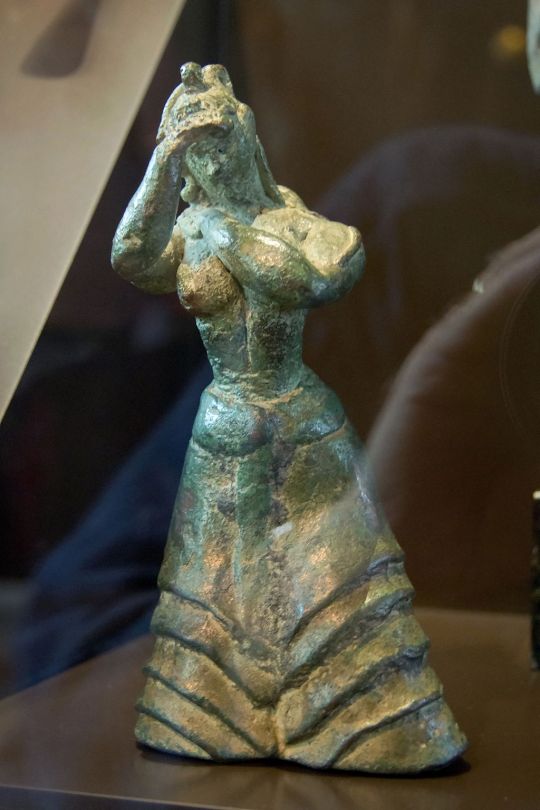
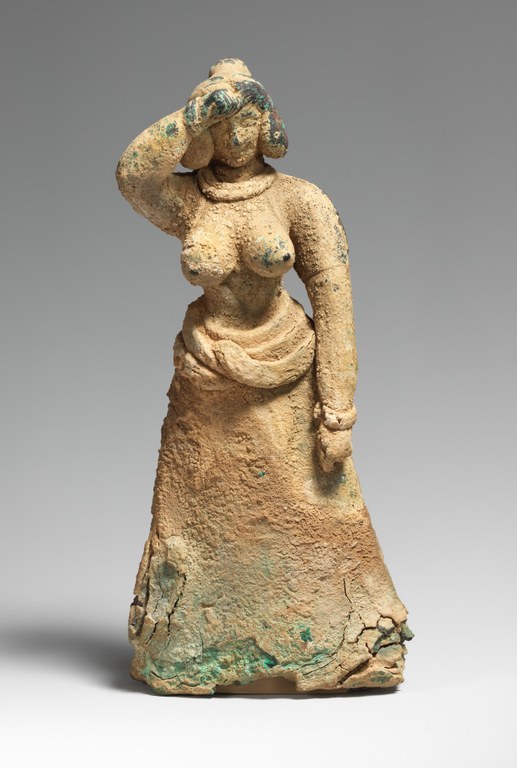
I think I see evidence of a continuous line from the skirt to the waist-roll on the figure on the left, found in Troas, which I think indicates some kind of skirt-folding situation. The woman on the right, found in Crete, looks more like she's wearing some kind of long coiled belt, or perhaps snakes. Who knows? I don't! For my own part, I found the combination of rolled waist + tie belt the most secure for doing things like kneeling, stomping around, and wading into rivers to rescue bees. I also liked that it gave me the bulk around the hips that gives Minoan figurines such a powerful silhouette, and proportionally gives more of an hourglass shape. If you wanted to do something more firmly grounded in the sources, stick just with the waist tie or belt, wrapped around a couple times and tied in back. If you want to be like me, just say "well we don't KNOW it didn't happen" and just do whatever you want. Have fun! Whatever happens, it should be fairly easy to move around in the kilt--this is not a restrictive garment, just a heavy one.
805 notes
·
View notes
Text

The mother Hecate
#I lied about the art thing#pixel art#americana#angel sighting proof of heaven#angel#official electrical pylon post#electrical pylon#transmission tower#diety#Hecate#Greek mythology#mythology#art#game dev#aseprite#salmon#minoan crete#minoan
22 notes
·
View notes
Text
"That Minoan and Mycenaean states pursued different strategies of political rule is reflected in different architectural plans found at Minoan and Mycenaean palaces.
Minoan palaces are designed around a large central court flanked by residential quarters, storage facilities, and ritual suites. The central court is the main space around which palace traffic circulated, and various wings of the building were most easily (or only) accessible via the central court (Driessen 2002 , 2004). Many Aegean prehistorians have accordingly advocated replacing the term “palace” with “court compound.” while the palace at Knossos has a “throne room,” its function appears to have been related more to ritual practices rather than political ones, and the throne itself is probably a later feature added during the Mycenaean period (Driessen 2002). Other Minoan palaces do not have throne rooms, and an iconography of the ruler is missing from Minoan representational art until the very end of the Neopalatial period (Davis 1995), which is very typical of corporate states (Blanton et al. 1996).
Moreover, there is an absence of very wealthy burials in Protopalatial and Neopalatial Crete that we might call “royal,” although there are major depositions of wealth within the palaces themselves. Recent work on Minoan palaces has, in fact, suggested that they were “communal, ceremonial centers that were used both by non-elite (outside) and by elite groups (inside) as meeting places for ritual, integrative actions” (Driessen 2002,). That the courts of the Minoan palaces were used for major communal rituals is indicated by two miniature frescoes found at Knossos, the Grandstand Fresco and the Sacred Grove Fresco.
The ritual role of Minoan palaces should not, however, diminish their administrative and economic roles, which were crucially important. Storage of agricultural staples was extensive in both Protopalatial and Neopalatial palaces (Christakis 2004, 2008), and the administrative texts of the Minoan palaces, while undeciphered, clearly monitor large amounts of foodstuffs alongside other valuable commodities and human labor (Palmer 1995). Even if these foodstuffs were ultimately destined for communal banqueting ceremonies, the economic impact of the Minoan palace cannot be ignored. It appears that Minoan economy and ritual were tightly integrated, not mutually exclusive, components of the larger, corporate state system (Day and Relaki 2002, 219–20).
Mycenaean palaces on the Greek mainland, on the other hand, are organized around a central “megaron” complex, which consists of a porch, an anteroom, and a large rectangular room with a central hearth bracketed by four columns and a throne regularly located to the right of the entrance. Flanking this megaron complex are small courts, storerooms, administrative quarters, and residential suites. Mycenaean architecture thereby emphasizes the importance of the enthroned king, whose title, as we know from the clay administrative tablets written in Linear B, was wanax (wa-na-ka).
Wealthy burials are an endemic feature of Mycenaean palatial societies and the communities that preceded them. At the palatial sites of Mycenae and Pylos, large corbeled “tholos” tombs are closely associated with the palace itself. These tombs have architectural precursors on the mainland in the form of Middle Bronze Age tumuli and on Crete in the form of large, circular tomb chambers (Rutter 1993, 789; Parkinson and Galaty 2007, 122). Mycenaean art, like Minoan art, lacks a clear iconography of the king himself; rather, the wall paintings of the palace act as a frame or focalizing device for the wanax, providing a ‘first-person’ (rather than ‘third-person’) iconography of power (Bennet 2007). As with the tholos tombs, the iconographic vocabulary of these artistic frames at Mycenaean palaces (e.g., heraldic lions/griffins, in-curved altars) is largely borrowed from the Minoan world.
In terms of political economy, Mycenaean palaces were interested in controlling the acquisition of exotic raw materials such as ivory, as well as their distribution as finished products (Burns 1999). Many of these goods are found deposited in rock-cut chamber tombs and corbeled tholos tombs, some of which are truly monumental (Cavanagh and Mee 1998). Palace-sponsored feasting is a feature common to all Mycenaean centers and arguably was one way for the palace to promote the centrality of the state, along with the individuals and corporate groups who contributed staples and material, in ritual practice. These features can be associated with network (as opposed to corporate) strategies that center on the individual and the control of prestige goods."
-State and Society, in The Oxford Handbook of the Bronze Age Aegean
#minoan crete#minoan society#minoan architecture#minoan palaces#mycenaean greece#mycenaean society#mycenaean architecture#mycenaean palaces#quotes#excerpts
15 notes
·
View notes
Text
”Girls are attracted to guys that look like their father”
Helios:

#greek mythology#minotaur#the minotaur#greek myths#pasiphae#king minos#ariadne#poseidon#helios#greek gods#minoan crete
28 notes
·
View notes
Text

The House of Asterion 🌙🐂

197 notes
·
View notes
Text

Arthur Evans' reconstruction of the Dolphin Frescos, Knossos Minoan archaeological site, Crete
#minoan#minoan art#minoan crete#minoan civilization#artistic#art#greek art#knossos#greece#creteisland
401 notes
·
View notes
Text

Crete, Greece on film in the 90s
#streetsnap#streetphotography#street photography#photography#classic film#35mm film#35mm color film#greece#minoan crete#cretegreece#crete
19 notes
·
View notes